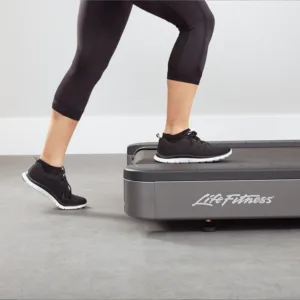
Look, we’ve seen way too many people get excited about a new treadmill, only to realize it won’t fit in their space—or worse, it fits but they’re constantly smacking their head on the ceiling. At 298 pounds, Big Mike has tested dozens of treadmills in our testing facility, and here’s what we want to tell you about treadmill ceiling clearance.
Spoiler alert: The “rule of thumb” most websites give you? It’s not enough for real people in real homes.
The Basic Formula
Here’s the deal: Stand straight up with your feet side by side. That’s your never-taller-than height. Now add 4 inches for safety (which includes 1 inch for shoes) plus the height of your treadmill deck. This is the height from the floor to the belt you would stand on.
Your height + 4 inches + Treadmill deck height = Minimum ceiling clearance needed
The 6’4″ Person Example
Let’s use a 6’4″ person because, honestly, that’s closer to Big Mike’s reality than the 5’8″ person most websites assume.
6’4″ = 76 inches
+ 4 inches (safety buffer includes 1″ for shoes)
+ Treadmill deck height (varies by model)
= Total clearance needed
So, for our 6’4″ friend:
- NordicTrack Commercial 1750 (10″ deck): 76 + 4 + 10 = 90 inches (7’6″)
See the problem? That NordicTrack needs 7.5 feet of clearance, but most people think “8-foot ceiling, I’m good.” Not so fast.
The Ceiling Height Reality Check
Here’s what really gets us: everyone assumes they have 8-foot ceilings. But ceiling heights in American homes have been all over the map and knowing your era matters.
Main Floor Ceiling Heights by Era:
Colonial/Early American (1600s-1700s): Around 7-8 feet. Why? Heating was expensive, and construction was basic. If you’re in a historic home, measure twice, buy once.
Victorian Era (1840s-1910s): 9-12 feet. These folks were showing off—high ceilings meant wealth. Lucky you if you’ve got a Victorian.
Early 20th Century (1900s-1940s): Generally, 8-9 feet. Decent for most treadmills, but measure to be sure.
Post-WWII/Ranch Era (1940s-1970s): Standardized at 8 feet. This was the “make housing affordable” era. Lumber comes in 8-foot lengths, drywall is 8 feet tall, and it kept costs down. If you’re in a ranch home from this era, you’re looking at exactly 8 feet—no wiggle room.
1980s-1990s: Still mostly 8 feet, though 9-foot ceilings started appearing in higher-end homes.
2000s-Present: 9 feet became the new standard, with 10-12 feet in luxury homes. Thank goodness for improved HVAC efficiency.
Regional Variations… Geography Matters
Southern homes historically had higher ceilings for air circulation—smart move before air conditioning. Northern homes went lower to retain heat. Makes sense when you think about it.
Basement Reality: Where Dreams Go to Die
Oh, basements. We’ve heard from users dealing with more cramped basements than we care to count. Here’s the brutal truth about basement ceiling heights:
Traditional/Historic Basements (pre-1950s): Often 6.5-7 feet. These were for utilities and storage, not your home gym dreams.
Mid-Century (1950s-1970s): Typically, 7-7.5 feet. Better, but still tight for bigger folks.
Modern Standard (1980s-present): 8 feet became the norm. Finally, livable space.
Current Trends: Many new homes feature 9-foot basement ceilings. About time.
Gotchas That’ll Get You:
- Ceiling fans: The thing everyone forgets until they’re ducking mid-run (trust me, Big Mike learned this the hard way)
- Ductwork and utilities: They eat up 6-12 inches of your ceiling height
- Drop ceilings: Can bring you down to 6.5-7 feet even in taller basements
- Building codes: Require minimum 7 feet of clear height for habitable space
- Finished vs. unfinished: Makes a huge difference in usable height
Bottom line: That 8-foot ceiling might actually be 7 feet once your account for utilities or that ceiling fan you forgot about. Do the math.
Deck Heights: The Numbers That Actually Matter
Here’s where most reviews fail you—they don’t tell you the actual deck height. We measured them all. These are the real numbers from our testing:
Low-Profile Options (Good for tight spaces):
- WalkingPad A1 Pro: 3″ deck height
- Echelon Stride: 5.25″ deck height
- Life Fitness T5: 6″ deck height
Standard Height Range:
- 3G Cardio Pro Runner X: 6.5″ deck height
- Life Fitness T3 Track Connect: 6.5″ deck height
- Spirit XT685: 6.75″ deck height
- Sole F80 (2024): 7.25″ deck height
- 3G Cardio Elite Runner X: 7.5″ deck height
- Horizon Fitness T101: 7.75″ deck height
Higher Decks (Measure twice, buy once):
- Life Fitness Club Series: 8″ deck height
- Sole F80 (older model): 8″ deck height
- Peloton Tread: 8″ deck height
- Horizon Fitness 7.0 AT: 8.6″ deck height
- Horizon Fitness 7.8 AT: 8.75″ deck height
- Inspire Fitness Tread 3: 9″ deck height
- NordicTrack Commercial 1750 (2024): 9″ deck height
- NordicTrack 2450 Commercial: 9.5″ deck height
- Life Fitness Club 95T Achieve: 10″ deck height
- NordicTrack Commercial 1750 (older): 10″ deck height
- ProForm Pro 2000 Smart: 11″ deck height
See the difference? A WalkingPad at 3 inches versus a ProForm at 11 inches is 8 inches of additional clearance needed. That’s the difference between fitting in a 7-foot basement or needing 8+ feet.
Don’t Pick a Treadmill Based on Deck Height Alone
Here’s the thing: just because a treadmill has a low deck height doesn’t mean it’s the best choice for you. Take the WalkingPad A1 Pro—yes, it’s only 3 inches high, perfect for tight spaces. But with an overall rating of 70/100, it’s not our top pick for performance or durability or anything other than WALKING (LOL).
Compare that to the 3G Cardio Elite Runner at 7.5 inches high with a 95/100 rating, or the Life Fitness T5 at 6 inches with a 94/100 rating. Sometimes an extra few inches of deck height gets you a significantly better machine.
Bottom line: Use deck height to narrow down what fits your space, then pick the best-rated treadmill from that group. We’ve tested them all and rated them for overall value, build quality, and big-guy performance. Check out our comparison charts to see how each model scores on the factors that really matter.
Big Mike’s Real-World Testing Insights
After testing these machines in our facility and hearing from users in everything from 7-foot basements to 12-foot great rooms, here’s what we’ve learned:
The “Bounce Factor”
When Big Mike really gets going at 298 pounds, there’s more vertical movement than you’d expect. That 4-inch buffer isn’t just for standing—it’s for the natural bounce that happens when you’re actually running, not just walking.
Incline Changes Everything
Most people forget that when you incline the treadmill, the back end goes up. We’ve seen people who could barely clear the machine at 0% grade suddenly have plenty of room at 15% incline because they’re effectively shorter on the raised platform.
The Shoe Factor
Running shoes add 1 inch to your height. Cross-trainers might add more. We included this in our calculations above—we’ve seen too many people who measured in socks and got surprised.
What This Means for Your Purchase Decision
Here’s the deal: If you’re working with tight clearance, deck height becomes a major factor in your treadmill choice.
Tight Space (Under 8 feet total clearance):
Stick with low-profile options like the WalkingPad A1 Pro (3″), Echelon Stride (5.25″), or Life Fitness T5 (6″). These give you the best chance of fitting without compromising your running form.
Standard Space (8-8.5 feet clearance):
You’ve got more options. The 3G Cardio Pro Runner (6.5″), Spirit XT685 (6.75″), or Sole F80 2024 (7.25″) all work well for most users.
Generous Space (9+ feet clearance):
Go nuts. The NordicTrack Commercial series, ProForm Pro 2000, or Life Fitness Club models are all in play.
The Bottom Line
Don’t guess on clearance. Measure your actual ceiling height, subtract any obstacles (ductwork, lights, etc.), then use our formula. A $3,000 treadmill that doesn’t fit is a $3,000 paperweight.
And remember: deck height isn’t just about clearance—it affects step-up comfort too. Decks under 8 inches for daily use are great, especially when you’re stepping on and off multiple times during interval training.
Final Verdict: Measure twice, buy once. Your ceiling height and the treadmill’s deck height will determine whether you’re comfortable or constantly ducking. Do the math first, celebrate later.
Rating: Essential knowledge/100
Want More Reviews or a Specific Product Reviewed?

Check out our unbiased comparison charts, real-user feedback and expert insights from Big Mike and his team.
Email us: support@bigguytreadmillreview.com
Interested in a forum here? Let us know via email!

